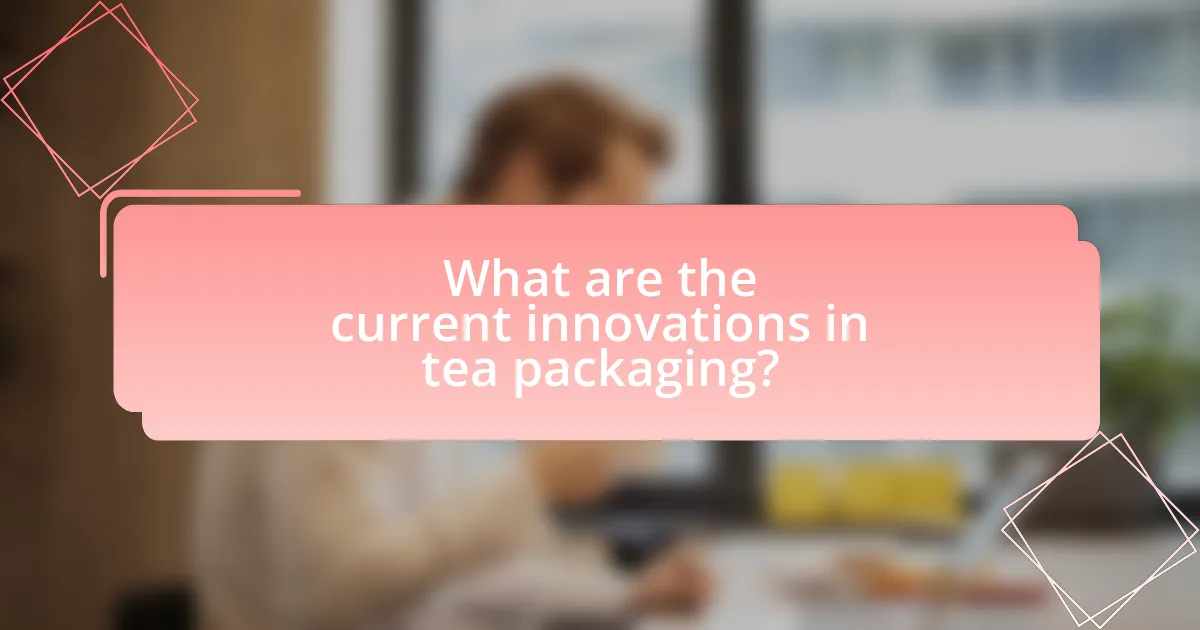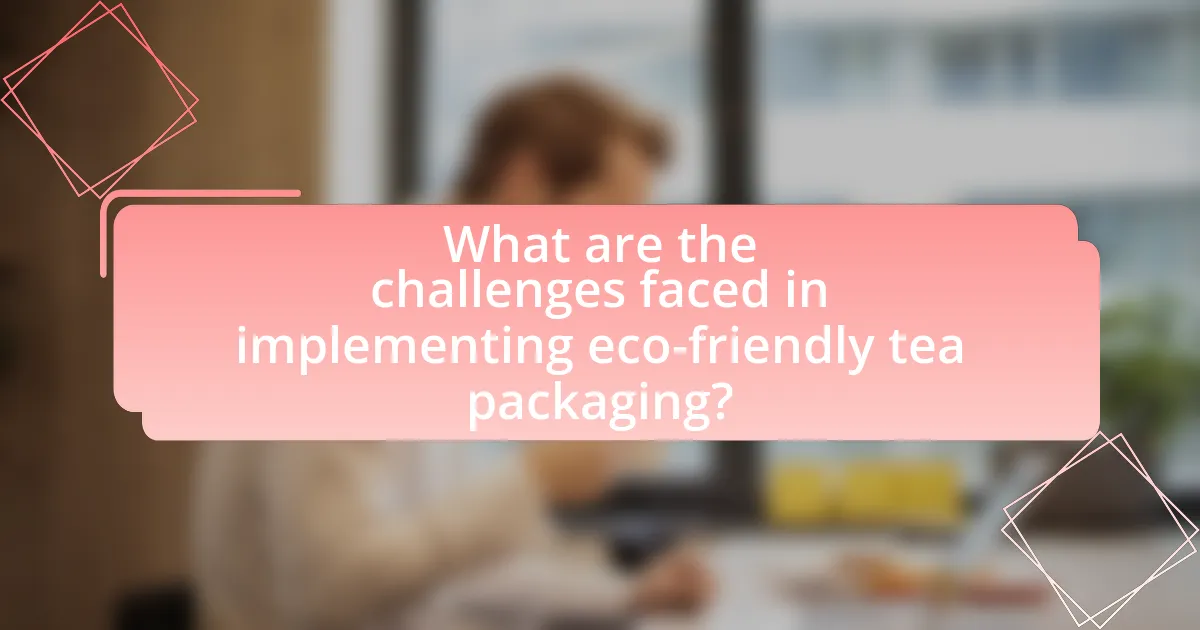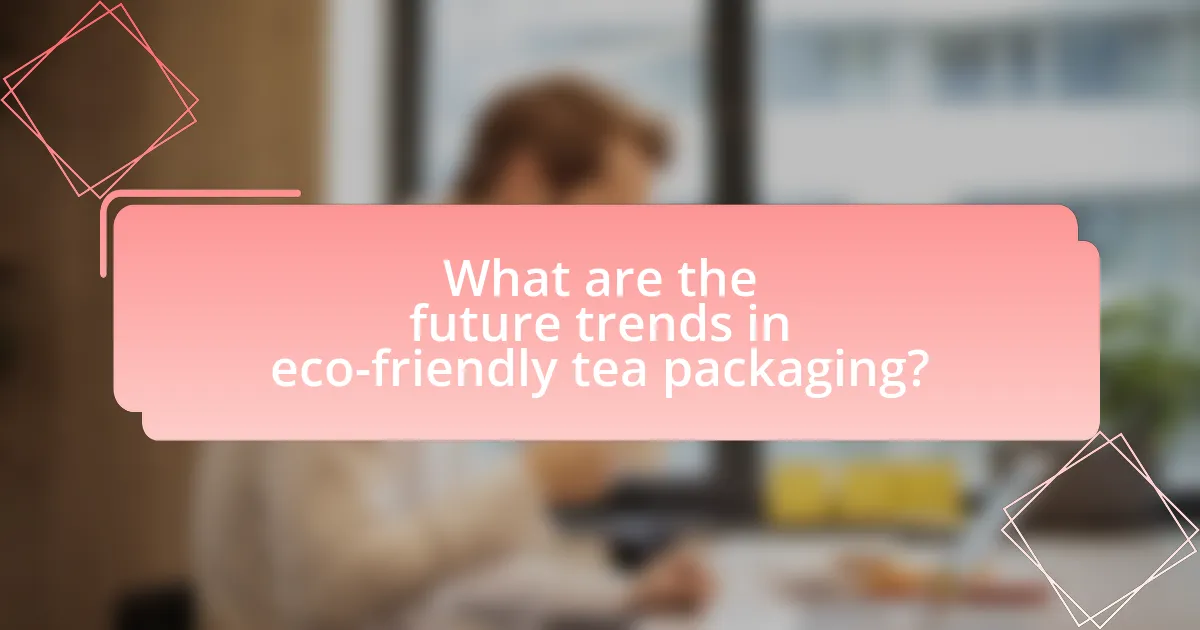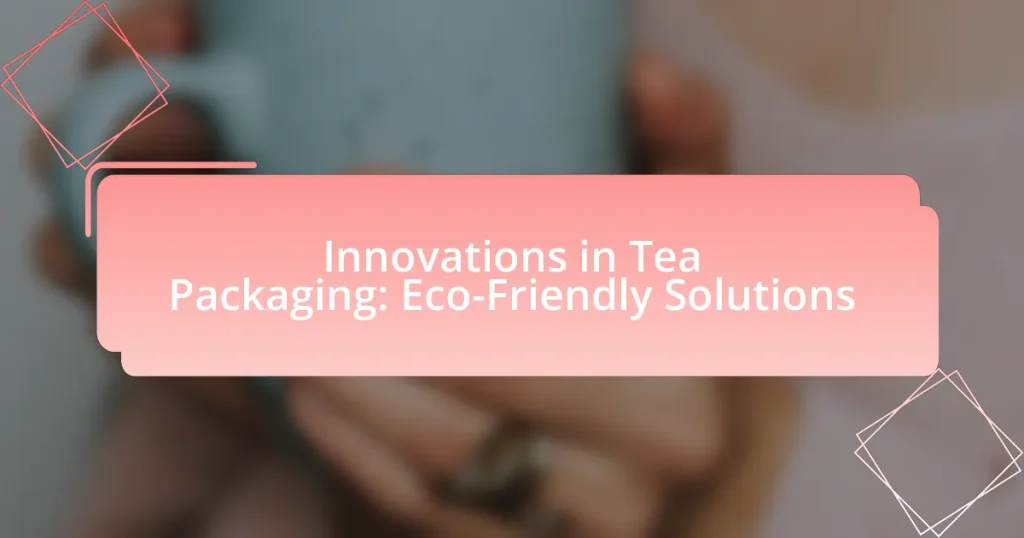The article focuses on innovations in tea packaging, emphasizing eco-friendly solutions that include biodegradable materials, compostable tea bags, and reusable packaging systems. It explores how companies are utilizing sustainable materials such as plant-based plastics and recycled paper to reduce environmental impact, while also addressing consumer preferences for environmentally responsible products. Additionally, the article discusses technological advancements like smart packaging and automation that enhance sustainability in tea packaging, as well as the challenges and regulatory standards that influence the adoption of these innovations. Future trends in the industry are highlighted, showcasing the ongoing commitment to reducing waste and promoting sustainable practices.

What are the current innovations in tea packaging?
Current innovations in tea packaging focus on eco-friendly solutions, including biodegradable materials, compostable tea bags, and reusable packaging systems. Biodegradable materials, such as plant-based plastics and paper, reduce environmental impact by decomposing naturally. Compostable tea bags made from materials like cornstarch or hemp eliminate plastic waste, as they break down in composting environments. Additionally, brands are adopting reusable packaging systems, encouraging consumers to refill containers, which minimizes single-use waste. These innovations reflect a growing commitment to sustainability in the tea industry, addressing consumer demand for environmentally responsible products.
How are eco-friendly materials being utilized in tea packaging?
Eco-friendly materials are utilized in tea packaging through the adoption of biodegradable, compostable, and recyclable materials such as plant-based plastics, paper, and natural fibers. Companies are increasingly replacing traditional plastic and aluminum with materials like PLA (polylactic acid), which is derived from cornstarch, and recycled paperboard, reducing environmental impact. For instance, brands like Pukka Herbs use biodegradable tea bags made from organic cotton, which decompose naturally, while others implement recyclable cardboard boxes to minimize waste. This shift not only meets consumer demand for sustainable products but also aligns with global efforts to reduce plastic pollution and promote environmental responsibility.
What types of biodegradable materials are being used?
Biodegradable materials used in tea packaging include plant-based plastics, paper, and compostable films. Plant-based plastics, such as polylactic acid (PLA), are derived from renewable resources like corn starch and can decompose in industrial composting facilities. Paper packaging, often sourced from sustainably managed forests, is biodegradable and recyclable, making it an eco-friendly option. Compostable films, made from materials like cellulose, break down into organic matter in composting environments, contributing to soil health. These materials are increasingly adopted in the tea industry to reduce environmental impact and promote sustainability.
How do these materials compare to traditional packaging options?
Eco-friendly packaging materials, such as biodegradable films and recycled paper, significantly outperform traditional packaging options like plastic and Styrofoam in terms of environmental impact. These innovative materials reduce waste and pollution, as they decompose naturally and are sourced from renewable resources, unlike conventional packaging that contributes to landfill overflow and ocean pollution. For instance, a study by the Ellen MacArthur Foundation highlights that switching to biodegradable packaging can reduce carbon emissions by up to 70% compared to traditional plastic packaging.
What technological advancements are influencing tea packaging?
Technological advancements influencing tea packaging include biodegradable materials, smart packaging, and automation in production processes. Biodegradable materials, such as plant-based plastics and compostable films, reduce environmental impact and align with eco-friendly initiatives. Smart packaging technologies, which incorporate QR codes and NFC tags, enhance consumer engagement by providing information about product origin and brewing instructions. Automation in production processes improves efficiency and consistency in packaging, allowing for faster turnaround times and reduced labor costs. These advancements collectively contribute to more sustainable and consumer-friendly tea packaging solutions.
How is smart packaging changing the tea industry?
Smart packaging is transforming the tea industry by enhancing product freshness, improving traceability, and providing consumer engagement through technology. This innovation allows for the integration of sensors and QR codes that monitor freshness and quality, ensuring that consumers receive optimal products. For instance, smart packaging can indicate the best-before date and provide information on the tea’s origin and brewing instructions, which enhances the consumer experience. Additionally, studies show that 70% of consumers prefer products with smart packaging features, indicating a strong market demand for these advancements.
What role does automation play in eco-friendly tea packaging?
Automation significantly enhances eco-friendly tea packaging by streamlining production processes and reducing waste. Automated systems can efficiently manage the use of sustainable materials, ensuring precise measurements and minimizing excess packaging. For instance, automation allows for the use of biodegradable or recyclable materials in a more consistent manner, which can lead to a reduction in the carbon footprint associated with packaging. Additionally, automated machinery can optimize energy consumption during production, further contributing to sustainability efforts. Studies indicate that companies implementing automation in their packaging processes have reported up to a 30% decrease in material waste, demonstrating the effectiveness of automation in promoting eco-friendly practices.
Why is sustainability important in tea packaging innovations?
Sustainability is crucial in tea packaging innovations because it reduces environmental impact and promotes responsible consumption. The tea industry generates significant waste through traditional packaging methods, which often involve non-biodegradable materials. By adopting sustainable packaging solutions, such as biodegradable or recyclable materials, companies can minimize waste and lower their carbon footprint. For instance, a study by the World Tea Conference found that 70% of consumers prefer brands that use eco-friendly packaging, indicating a market demand for sustainability. This shift not only benefits the environment but also enhances brand loyalty and consumer trust.
What environmental impacts are associated with traditional tea packaging?
Traditional tea packaging often involves materials like plastic, aluminum, and non-biodegradable paper, which contribute significantly to environmental pollution. The use of plastic in tea bags can lead to microplastic contamination in soil and water systems, as these materials do not decompose easily. Additionally, aluminum packaging requires extensive energy for production and contributes to greenhouse gas emissions. According to a study published in the Journal of Cleaner Production, the lifecycle of traditional tea packaging results in substantial carbon footprints due to resource extraction, manufacturing, and disposal processes. These factors collectively highlight the negative environmental impacts associated with traditional tea packaging.
How do consumer preferences drive sustainable packaging solutions?
Consumer preferences significantly drive sustainable packaging solutions by increasing demand for environmentally friendly materials and practices. As consumers become more environmentally conscious, they actively seek products with minimal ecological impact, prompting companies to adopt sustainable packaging options. For instance, a 2021 survey by McKinsey & Company found that 67% of consumers consider sustainability when making purchasing decisions, leading brands to innovate with biodegradable, recyclable, or reusable packaging. This shift not only aligns with consumer values but also enhances brand loyalty and market competitiveness, as companies that prioritize sustainability often see increased sales and customer retention.

What are the challenges faced in implementing eco-friendly tea packaging?
The challenges faced in implementing eco-friendly tea packaging include higher production costs, limited availability of sustainable materials, and consumer acceptance. Higher production costs arise because eco-friendly materials often require more expensive sourcing and processing methods compared to conventional packaging. Limited availability of sustainable materials can hinder manufacturers’ ability to find suitable alternatives that meet both environmental standards and product integrity. Additionally, consumer acceptance poses a challenge, as some consumers may prioritize convenience or aesthetics over sustainability, impacting market demand for eco-friendly options. These factors collectively complicate the transition to eco-friendly packaging solutions in the tea industry.
What are the cost implications of switching to eco-friendly materials?
Switching to eco-friendly materials typically incurs higher initial costs compared to conventional materials. For instance, studies indicate that biodegradable packaging can be 10-30% more expensive due to the sourcing of sustainable raw materials and the manufacturing processes involved. However, these costs can be offset over time through benefits such as reduced waste disposal fees and potential tax incentives for sustainable practices. Additionally, consumer demand for eco-friendly products can lead to increased sales, as evidenced by a Nielsen report showing that 66% of global consumers are willing to pay more for sustainable brands.
How do production costs compare between traditional and eco-friendly packaging?
Production costs for eco-friendly packaging are generally higher than those for traditional packaging. This is primarily due to the more expensive materials and processes involved in creating sustainable options, such as biodegradable plastics or recycled materials. For instance, a study by Smithers Pira indicates that eco-friendly packaging can cost up to 30% more than conventional packaging due to these factors. However, the long-term benefits, including reduced environmental impact and potential consumer preference for sustainable products, can offset these initial costs.
What financial incentives exist for companies adopting sustainable practices?
Companies adopting sustainable practices can benefit from various financial incentives, including tax credits, grants, and reduced operational costs. For instance, governments often provide tax incentives for businesses that invest in renewable energy or energy-efficient technologies, which can significantly lower their tax liabilities. Additionally, organizations may qualify for grants aimed at promoting sustainability initiatives, such as funding for eco-friendly packaging solutions. Furthermore, adopting sustainable practices can lead to reduced operational costs through energy savings and waste reduction, ultimately improving profit margins. According to a report by the World Economic Forum, companies that implement sustainable practices can see a return on investment of up to 30% through efficiency gains and enhanced brand loyalty.
How do regulatory standards affect eco-friendly tea packaging?
Regulatory standards significantly influence eco-friendly tea packaging by establishing guidelines that manufacturers must follow to ensure sustainability and safety. These standards often require the use of biodegradable materials, limit harmful substances, and promote recycling practices, thereby encouraging companies to adopt environmentally responsible packaging solutions. For instance, regulations in the European Union mandate that packaging materials must be recyclable or compostable, which drives tea producers to innovate and utilize materials like plant-based plastics or recycled paper. Compliance with these standards not only helps protect the environment but also enhances brand reputation among eco-conscious consumers, as evidenced by a 2021 survey indicating that 73% of consumers prefer brands that prioritize sustainable packaging.
What regulations must companies comply with when using new materials?
Companies must comply with regulations such as the European Union’s REACH (Registration, Evaluation, Authorisation and Restriction of Chemicals) and the U.S. Toxic Substances Control Act (TSCA) when using new materials. REACH requires companies to register chemical substances and assess their safety, while TSCA mandates the evaluation of new chemicals before they can be manufactured or imported. Compliance with these regulations ensures that new materials are safe for human health and the environment, which is particularly important in eco-friendly innovations in tea packaging.
How do these regulations vary across different regions?
Regulations regarding eco-friendly tea packaging vary significantly across different regions. In the European Union, stringent regulations mandate the use of recyclable materials and limit single-use plastics, promoting sustainability in packaging. Conversely, in the United States, regulations are less uniform, with some states implementing their own packaging laws while others follow federal guidelines that focus more on consumer safety than environmental impact. In countries like Japan, there is a strong cultural emphasis on sustainability, leading to innovative practices in biodegradable packaging, supported by government incentives. These regional differences reflect varying levels of environmental awareness and regulatory frameworks, influencing how tea packaging innovations are developed and implemented.

What are the future trends in eco-friendly tea packaging?
Future trends in eco-friendly tea packaging include the use of biodegradable materials, compostable tea bags, and innovative designs that minimize waste. Biodegradable materials, such as plant-based plastics and recycled paper, are gaining traction as they break down naturally, reducing environmental impact. Compostable tea bags made from materials like cornstarch or hemp are becoming popular, as they decompose without leaving harmful residues. Additionally, brands are focusing on minimalistic packaging designs that reduce excess material and promote sustainability, aligning with consumer demand for environmentally responsible products. These trends are supported by a growing awareness of environmental issues and consumer preferences for sustainable options in the food and beverage industry.
How is consumer awareness shaping the future of tea packaging?
Consumer awareness is significantly shaping the future of tea packaging by driving demand for sustainable and eco-friendly materials. As consumers increasingly prioritize environmental responsibility, tea brands are responding by adopting biodegradable, recyclable, and compostable packaging options. For instance, a 2021 survey by Nielsen indicated that 73% of global consumers are willing to change their consumption habits to reduce environmental impact, prompting companies to innovate in packaging design and materials. This shift not only meets consumer expectations but also enhances brand loyalty and market competitiveness, as seen with brands like Pukka Herbs, which uses fully recyclable packaging.
What role does education play in promoting sustainable packaging choices?
Education plays a crucial role in promoting sustainable packaging choices by increasing awareness and understanding of environmental impacts associated with packaging materials. Through educational programs, consumers learn about the benefits of eco-friendly packaging options, such as biodegradable materials and reduced plastic use, which can lead to more informed purchasing decisions. Research indicates that consumers who are educated about sustainability are more likely to choose products with sustainable packaging; for instance, a study published in the Journal of Cleaner Production found that awareness campaigns significantly increased the likelihood of consumers opting for eco-friendly packaging solutions. This demonstrates that education not only informs but also influences consumer behavior towards sustainable practices in packaging.
How are brands responding to consumer demand for eco-friendly options?
Brands are increasingly adopting eco-friendly options in response to consumer demand by implementing sustainable packaging solutions and sourcing organic ingredients. For instance, many tea brands are transitioning from plastic to biodegradable materials for their tea bags and packaging, reflecting a commitment to reducing environmental impact. A notable example is the use of plant-based materials, such as cornstarch or hemp, which are being utilized to create compostable tea bags. Additionally, brands are emphasizing transparency in their sourcing practices, with a growing number of companies obtaining certifications like Fair Trade and USDA Organic to appeal to environmentally conscious consumers. This shift is supported by research indicating that 66% of global consumers are willing to pay more for sustainable brands, highlighting the market’s responsiveness to eco-friendly initiatives.
What innovations can we expect in the next decade?
In the next decade, we can expect significant innovations in eco-friendly tea packaging, focusing on biodegradable materials and sustainable sourcing. Companies are increasingly adopting plant-based plastics and compostable materials to reduce environmental impact, as evidenced by the rise of brands like Pukka Herbs, which utilizes fully biodegradable packaging. Additionally, advancements in smart packaging technology will enhance freshness and shelf life while minimizing waste, aligning with consumer demand for sustainability. Research indicates that the global biodegradable packaging market is projected to reach $400 billion by 2025, highlighting the growing trend towards eco-conscious solutions in the food and beverage industry.
How might advancements in technology further enhance sustainability?
Advancements in technology can enhance sustainability by enabling the development of biodegradable and recyclable materials for tea packaging. For instance, innovations such as plant-based plastics and compostable films reduce reliance on traditional petroleum-based materials, which contribute to environmental pollution. Research from the University of Cambridge indicates that biodegradable materials can significantly decrease landfill waste, as they break down more efficiently than conventional plastics. Furthermore, smart packaging technologies can monitor freshness and reduce food waste, aligning with sustainability goals by ensuring that products are consumed before they spoil. These technological advancements not only improve the environmental footprint of tea packaging but also promote a circular economy by facilitating recycling and reducing resource consumption.
What new materials are being researched for future tea packaging?
Biodegradable materials such as polylactic acid (PLA) and mushroom-based packaging are being researched for future tea packaging. These materials are gaining attention due to their environmental benefits, as they decompose naturally and reduce plastic waste. Research published in the journal “Sustainability” by authors from the University of Cambridge highlights the potential of these materials to replace traditional plastic packaging, emphasizing their ability to maintain product freshness while being eco-friendly.
What best practices can companies adopt for eco-friendly tea packaging?
Companies can adopt several best practices for eco-friendly tea packaging, including using biodegradable materials, minimizing packaging waste, and implementing recyclable designs. Biodegradable materials, such as plant-based plastics or compostable paper, break down naturally, reducing environmental impact. Minimizing packaging waste involves designing smaller, more efficient packages that use less material while still protecting the product. Implementing recyclable designs ensures that packaging can be easily processed after use, promoting a circular economy. According to a study by the World Economic Forum, sustainable packaging can significantly reduce carbon footprints, highlighting the importance of these practices in the tea industry.


